The College of William and Mary did not decide on a whim to admit women. While the College was busily preparing for the first co-ed incoming class, there was a war raging across the Atlantic in Europe.
World War I had begun four years earlier, and the United States joined the previous year, 1917. In the summer of 1918, the country was unsure of how long the war would continue, and had to prepare for the worst. The College's admissions were probably dropping as prospective and returning William and Mary students were being shipped off to the European front, and something had to be done to try to raise or at least maintain enrollment at the small institution.
On August 10, 1918, previous male students of the College received a letter from the registrar H.L. Bridges urging them to return to William and Mary. The registrar stated that he understood that "there seems to be some doubt in the minds of students as to what they should do next session," but urged them to enroll for the fall semester. Why would the registrar be urging possibly needed soldiers to stay on the homefront? The registrar's letter went onto explain that "provision is being made to train all college students while they are doing their regular [college] work....The War Department wants you in college next year."
Instead of shutting down the educational opportunities for the men who had not been drafted, and possibly saving small colleges, such as William and Mary from closing their doors, the United States government wanted to keep their prospective soldiers prepared for possible deployment as well as educated.
The registrar may have also been pushing this new option on returning male students to possibly offset the effect of women coming on campus. If women did not make up a significant percentage of the incoming class, than their influence in the fall would be limited or not even felt. Also, co-education was still an untried experiment. If the experiment did not work out, and the war continued for multiple years, then the College might have been in an enrollment bind from which it could not free itself.
However, none of the worst case scenarios came to pass. World War I ended in November 1918, and co-education at the College was successful. But, it is interesting to see how people were reacting to and preparing for the unforeseen continuation of World War I.
The letter cited in this post is available in the folder "World War I" in the University Archives Subject File Collection in the Special Collections Research Center.
This post was composed by Jordan Ecker.
For additional information about the first women students at the College of William and Mary see: When Mary Entered with her Brother William: Women at the College of William and Mary, 1918-1945 by Laura F. Parrish; "The Petticoat Invasion": Women at the College of William and Mary, 1918-1945; The Martha Barksdale Papers; and the Women at the College of William and Mary page on the Special Collections Research Center Wiki.
August 10, 2008
July 11, 2008
July 1918: The New Dean of Women
Sometime during the summer months of 1918, President Lyon G. Tyler chose Caroline Tupper to be the first Dean of Women at the College of William and Mary. Unfortunately, there is not a great deal of information known about Dean Tupper. What is known has come from Laura Parrish's thesis. Parrish uncovered that Tupper was from Charleston, South Carolina and received her BA, MA, and Ph.D. in English from Radcliffe College in Cambridge, Massachusetts. Prior to coming to the College, the thesis explains that Tupper "had previously taught high school and college English. She was in Virginia in 1918 working as a housing and employment secretary,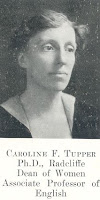 helping wives of servicemen find homes and jobs near their husbands' military camps."
helping wives of servicemen find homes and jobs near their husbands' military camps."
Tyler explained in a June 4, 1918 letter to Dr. Walter Montgomery that he wanted a woman who "the young ladies might look for example" to be the Dean of Women, and it appears that Tupper fit that description. From the recollections of Janet Coleman Kimbrough, one of those first women students, it appears that Tupper "was quite liberal for the period," who wanted the women to do things through "tradition" rather than create rules. Tupper's liberalness was fine under the Tyler administration, but when President Julian Alvin Carroll Chandler became president in 1919, it was less acceptable. It appears from the student recollections that halfway through the 1919-1920 school year, Tupper resigned from the College of William and Mary.
Though Tupper was not the Dean of Women for very long, she made an impact during the first year of co-education. From what little information there is about Tupper, it appears as though she was a forward thinker who refused to create and enforce rules for women just because they were women.
Information about Tupper in the Special Collections Research Center includes photographs, collected information in the University Archives Faculty-Alumni File Collection, and the memories of Janet Coleman Kimbrough in the University Archives Oral History Collection. For more information on Caroline Tupper, you may wish to contact Harvard University's Radcliffe Institute for Advance Study's Schlesinger Library, which currently holds the former Radcliffe College archives.
This post was composed by Jordan Ecker.
For additional information about the first women students at the College of William and Mary see: When Mary Entered with her Brother William: Women at the College of William and Mary, 1918-1945 by Laura F. Parrish; "The Petticoat Invasion": Women at the College of William and Mary, 1918-1945; The Martha Barksdale Papers; and the Women at the College of William and Mary page on the Special Collections Research Center Wiki.
 helping wives of servicemen find homes and jobs near their husbands' military camps."
helping wives of servicemen find homes and jobs near their husbands' military camps."Tyler explained in a June 4, 1918 letter to Dr. Walter Montgomery that he wanted a woman who "the young ladies might look for example" to be the Dean of Women, and it appears that Tupper fit that description. From the recollections of Janet Coleman Kimbrough, one of those first women students, it appears that Tupper "was quite liberal for the period," who wanted the women to do things through "tradition" rather than create rules. Tupper's liberalness was fine under the Tyler administration, but when President Julian Alvin Carroll Chandler became president in 1919, it was less acceptable. It appears from the student recollections that halfway through the 1919-1920 school year, Tupper resigned from the College of William and Mary.
Though Tupper was not the Dean of Women for very long, she made an impact during the first year of co-education. From what little information there is about Tupper, it appears as though she was a forward thinker who refused to create and enforce rules for women just because they were women.
Information about Tupper in the Special Collections Research Center includes photographs, collected information in the University Archives Faculty-Alumni File Collection, and the memories of Janet Coleman Kimbrough in the University Archives Oral History Collection. For more information on Caroline Tupper, you may wish to contact Harvard University's Radcliffe Institute for Advance Study's Schlesinger Library, which currently holds the former Radcliffe College archives.
This post was composed by Jordan Ecker.
For additional information about the first women students at the College of William and Mary see: When Mary Entered with her Brother William: Women at the College of William and Mary, 1918-1945 by Laura F. Parrish; "The Petticoat Invasion": Women at the College of William and Mary, 1918-1945; The Martha Barksdale Papers; and the Women at the College of William and Mary page on the Special Collections Research Center Wiki.
June 25, 2008
June 25, 1918: A Visitor Protests and Preparing for the Marys
At the June 25th meeting of the Board of Visitors, member Major James New Stubbs "offered a resolution to the effect that the Strode Bill was in direct opposition to the 1906 contract by which the Commonwealth of Virginia had taken full responsibility for the College of William and Mary and that therefore the College should refuse to accept women. The 1906 act had specifically stated that William and Mary was to educate men, and admitting women was a violation of that contract. Stubbs argued that the contract would have to be renegotiated before women could be admitted." (Laura Parrish, When Mary Entered with Her Brother William: Women Students at the College of William and Mary, 1918-1945, M.A. thesis)
The Visitors voted six to one against Stubbs' resolution. Stubbs had not been in attendance at the Board's February 12th meeting where members Hughes, Richardson, and Hutcheson voted against a motion of support for the Strode Bill, but within the week Stubbs contacted William and Mary President Lyon Gardiner Tyler in protest to no avail.
After voting down Stubbs' motion, the Board of Visitors moved on to other business including allocating funds to prepare a Women's Department and the salary for a woman to oversee the women's dormitory.
 The Board of Visitors approves the compensation of the lady in charge of the women's dormitory.
The Board of Visitors approves the compensation of the lady in charge of the women's dormitory.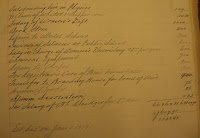
The section of the 1918-1919 budget with expenses for fitting a Women's Department and compensation for a lady in charge of the women's dormitory.
For additional information about the first women students at the College of William and Mary see: When Mary Entered with her Brother William: Women at the College of William and Mary, 1918-1945 by Laura F. Parrish; "The Petticoat Invasion": Women at the College of William and Mary, 1918-1945; The Martha Barksdale Papers; and the Women at the College of William and Mary page on the Special Collections Research Center Wiki.
For additional information about the first women students at the College of William and Mary see: When Mary Entered with her Brother William: Women at the College of William and Mary, 1918-1945 by Laura F. Parrish; "The Petticoat Invasion": Women at the College of William and Mary, 1918-1945; The Martha Barksdale Papers; and the Women at the College of William and Mary page on the Special Collections Research Center Wiki.
Labels:
Board of Visitors,
Buildings,
Faculty and Staff
June 10, 2008
June 10, 1918: Assembling the Faculty
 Routine business at the June 10th meeting of the College of William and Mary's Board of Visitors included the formal election by the BOV of faculty for the 1918-1919 academic year including Miss Caroline F. Tupper as the College's first Dean of Women.
Routine business at the June 10th meeting of the College of William and Mary's Board of Visitors included the formal election by the BOV of faculty for the 1918-1919 academic year including Miss Caroline F. Tupper as the College's first Dean of Women. The Boarding House Committee of the BOV made several recommendations at this meeting including hiring a "Lady in charge" in the women's dormitory who would report to the Dean of Women.
The Boarding House Committee of the BOV made several recommendations at this meeting including hiring a "Lady in charge" in the women's dormitory who would report to the Dean of Women.Finally, the
 Finance Committee reported that there was up to $1,000 to spend repairing the dormitory for the women due on campus in September.
Finance Committee reported that there was up to $1,000 to spend repairing the dormitory for the women due on campus in September.For additional information about the first women students at the College of William and Mary see: When Mary Entered with her Brother William: Women at the College of William and Mary, 1918-1945 by Laura F. Parrish; "The Petticoat Invasion": Women at the College of William and Mary, 1918-1945; The Martha Barksdale Papers; and the Women at the College of William and Mary page on the Special Collections Research Center Wiki.
Labels:
Board of Visitors,
Buildings,
Dean of Women,
Faculty and Staff
June 4, 2008
June 4, 1918: President Tyler Makes Plans for the Marys
As the school year was winding down at the College of William and Mary, President Lyon Gardiner Tyler was in the process of adjusting the College for the incoming class of women. On June 4, he wrote a letter to Dr. Walter Montgomery, asking his opinion on a candidate for the new Dean of Womenposition, Eleanor W. Bouldin. In the letter, Tyler asked Montgomery if her "scholarship rank[s] with the professors of the college [because] the Dean of Women is to be given a place in the faculty."
While Bouldin did not become the Dean of Women, this letter shows that President Tyler did not want to offer just any woman the position, but went through the same hiring process that he did for all other positions at the College. He was attempting to find the best candidate for the job to provide the incoming women with the appropriate guidance to help them transition into their new environment.
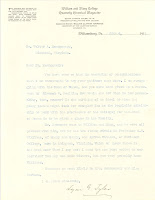
Letter to Dr. Walter Montgomery from Lyon Gardiner Tyler, dated June 4, 1918, discussing a possible candidate for the new Dean of Women position. Office of the President, Lyon Gardiner Tyler, Box 2, Folder "Co-education, 1910-1919." Click on image to enlarge.
This post was composed by Jordan Ecker.
For additional information about the first women students at the College of William and Mary see: When Mary Entered with her Brother William: Women at the College of William and Mary, 1918-1945 by Laura F. Parrish; "The Petticoat Invasion": Women at the College of William and Mary, 1918-1945; The Martha Barksdale Papers; and the Women at the College of William and Mary page on the Special Collections Research Center Wiki.

Letter to Dr. Walter Montgomery from Lyon Gardiner Tyler, dated June 4, 1918, discussing a possible candidate for the new Dean of Women position. Office of the President, Lyon Gardiner Tyler, Box 2, Folder "Co-education, 1910-1919." Click on image to enlarge.
This post was composed by Jordan Ecker.
For additional information about the first women students at the College of William and Mary see: When Mary Entered with her Brother William: Women at the College of William and Mary, 1918-1945 by Laura F. Parrish; "The Petticoat Invasion": Women at the College of William and Mary, 1918-1945; The Martha Barksdale Papers; and the Women at the College of William and Mary page on the Special Collections Research Center Wiki.
May 8, 2008
May 8, 1918: The Flat Hat Recaps the Meeting of the Board of Visitors
The May 8, 1918, edition of the Flat Hat provided a brief summary of the April 19th meeting of the Board of Visitors on its front page including continuing preparations for the arrival of the College of William and Mary's first female students in the fall. Meanwhile, the newspaper's second page (incorrectly dated March 8, 1918) included a plea over two columns entitled "Urged to Stay in College." The presence of the article offers further illustration of William and Mary's precarious enrollment as numbers declined due to the ongoing conflict of war, personal economics, and other reasons.
For additional information about the first women students at the College of William and Mary see: When Mary Entered with her Brother William: Women at the College of William and Mary, 1918-1945 by Laura F. Parrish; "The Petticoat Invasion": Women at the College of William and Mary, 1918-1945; The Martha Barksdale Papers; and the Women at the College of William and Mary page on the Special Collections Research Center Wiki.
For additional information about the first women students at the College of William and Mary see: When Mary Entered with her Brother William: Women at the College of William and Mary, 1918-1945 by Laura F. Parrish; "The Petticoat Invasion": Women at the College of William and Mary, 1918-1945; The Martha Barksdale Papers; and the Women at the College of William and Mary page on the Special Collections Research Center Wiki.
Labels:
Board of Visitors,
Flat Hat,
Lyon Gardiner Tyler,
World War I
May 6, 2008
May 1918: The Colonial Echo on Coeds
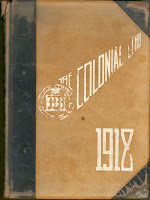 As the class of 1918 prepared to graduate from William and Mary, there were some mixed messages from the student body about their feelings of being the last all male class at the College in the yearbook, the Colonial Echo.
As the class of 1918 prepared to graduate from William and Mary, there were some mixed messages from the student body about their feelings of being the last all male class at the College in the yearbook, the Colonial Echo.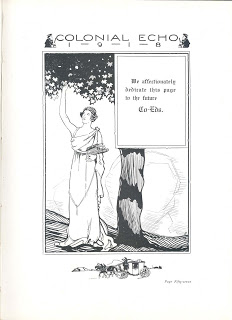
At the end of the senior class history on page 36 of the yearbook, the class historian remarked on the “melancholy fact that we are the last class to graduate from this old college before it is defiled by co-education.” While this may imply the historian’s dismay with the College becoming co-educational, twenty-one pages later on page 57 the Colonial Echo “affectionately dedicates this page to the future Co-Eds.”
This yearbook is an excellent example of the conflicting opinions about co-education at William and Mary in the months leading up to the first twenty female students’ arrival in September 1918. As previous entries about Flat Hat opinion articles have shown, there was a small, but vocal, contingent against co-education, which is represented in the yearbook by the historian’s parting line in the class history. At William and Mary, there were also quite a few students and faculty who were either indifferent or supported the arrival of women.
Click to enlarge the senior class history:
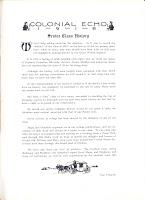
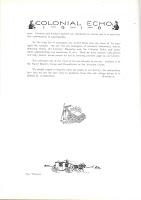
For more information on co-education’s reception on campus, as well as other questions, please contact the Special Collections Research Center, Swem Library, College of William and Mary.
This post was composed by Jordan Ecker.
For additional information about the first women students at the College of William and Mary see: When Mary Entered with her Brother William: Women at the College of William and Mary, 1918-1945 by Laura F. Parrish; "The Petticoat Invasion": Women at the College of William and Mary, 1918-1945; The Martha Barksdale Papers; and the Women at the College of William and Mary page on the Special Collections Research Center Wiki.
Subscribe to:
Posts (Atom)


